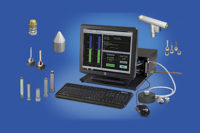Aside from the obvious quality pitfalls of using gages that are not accurate, avoiding calibration can be costly in other ways. Without a proper calibration schedule, companies can face decreased productivity and the loss of business contracts because of the lack of measuring compliance or certification.
With such high stakes, one might assume that proper resources, methods and budgets are commonly deployed for calibration programs. On the contrary, it is fairly typical for users to make the mistake of attempting to calibrate their own gages using incorrect methods and tools for perceived savings and convenience.
It is easy, right?
Some companies may think that calibrating is a quick and simple fix. These are the companies that grab a few gage blocks, perform a hasty inspection using crude measurement principles and assume they are done. What is not taken into account is the record keeping, training, follow up, maintenance of master standards, environment, official procedures and other issues that affect correct calibration. Companies often are misinformed on acceptable tools and methods for performing calibration.
In-house calibration, especially comprehensive, established programs in large companies that have thousands of gages, can be an effective approach for the right application. However, outsourcing calibration is perhaps the most prudent method for a variety of reasons, among the most prominent being cost and competence.
Outsourcing reduces cost, increases reliability
If a company is committed to correct calibration, outsourcing will save money and headaches. After factoring in the cost of hiring qualified technicians, buying sophisticated equipment, training and record keeping -- all of which is essential to guarantee certifiable results -- it is surely no small expense to do it in-house.
Indeed, the break-even expenses for companies that are brave enough, or large-scale enough, to attempt calibration in-house are estimated to be well into the thousands. At a minimum, it is around $250,000 for initial ramp up with equipment, depending on the application. Then probably another $100,000 for technicians. And that is not including other issues like taking up valuable manufacturing space to build a climate-controlled lab. A good annual cost estimate to operate an in-house lab would be over $ 75,000. In other words, unless the company has a tremendous amount of gages, it is cost prohibitive to set up an in-house calibration operation.
Standard problems, quality solutions
One example of how expensive it can be to calibrate could be made with gage block standards.
If a company wants to achieve a low level of uncertainty, such as I2 or 3 millionths of an inch, this requires the company to send a master set of blocks directly to the National Institute of Standards and Technology (NIST). The cost could be astronomical-up to $40,000 for a full set of inch and metric masters. The alternative would be to send the blocks to an accredited laboratory that has already paid the expense to have their master blocks calibrated through NIST. The savings can be significant. Typical costs to calibrate gage blocks range from $2 to $5 per block for a commercial laboratory vs. $80 per block when calibrated by NIST.
Cost is not the only advantage to outsourcing. Other critical issues, such as standards, also come into view. Is the company using an A2LA 17025 accredited source? An appropriately accredited lab will ensure compliance to today's standards. Consider also that today's standard may change tomorrow. Keeping up with the continually changing requirements is difficult at best for those unfamiliar with the process.
Other benefits are improved quality, reliability and convenience. It is safe to conclude that if a company is consistently using a dedicated, independent source, then quality will increase. In addition, larger companies benefit by standardizing gage calibration and record keeping within one source.
Who will do what?
Be informed about the choices when sending gages out for calibration. There are several options based on a company's needs. Depending on the work required, the gage could be sent to the manufacturer or maybe to a lab. The problem with going to the manufacturer is that many lack comprehensive calibration and repair services. Companies should determine if the manufacturer has an established repair and calibration program with thorough procedures.
Another problem with going to the manufacturer is multiple sourcing of gages. If a company has gages made by different manufacturers -- as most firms do -- it becomes difficult trying to send tools to various sources. Be sure they can handle all major brands of gages in one location. Another risk to consider is the type of lab. A company may discover what they think is a good calibration house, perhaps even a specialist in certain product areas, but there may be other drawbacks to the company such as its size. It is not uncommon to see one- or two-person calibration labs close without warning. Also, look for adequate equipment, experience and ability to service effectively. A good guideline for turnaround is a minimum of three days and a maximum of 10 days.
Of course there are downsides to outsourcing. After the gages leave the plant, a backup plan is needed; otherwise the company has no way to measure parts. Scheduling is vital so as not to interrupt production. Although it is rare, a gage can even be lost in transit, or if not packaged correctly, damaged.
Although it's true that gages won't last forever, regularly scheduled calibration, performed properly, can produce lasting gage accuracy and repeatability.
Tech Tips
- Outsourcing is perhaps the most prudent method for calibrating gages for a variety of reasons, among the most prominent being cost and competence.
- Outsourcing allows manufacturers to tap into the expertise of a calibration service without the headache and cost of setting up an in-house calibration program.
- Be sure to use a calibration source that is fully equipped, has comprehensive services and the ability to handle all major brands of gages at one location.
- Before gages leave the plant, have a back up plan in place to avoid interruptions in production schedules.
